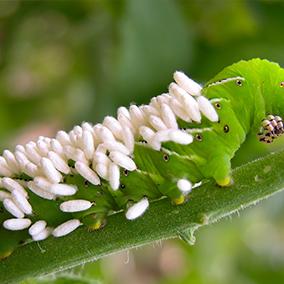
So... What are Leafminers?
Leafminers are the larvae of various insects including beetles, flies and moths. Larvae are usually very small, reaching between 1/8" and 1/5" in length.
The leafminer larvae live inside of the leaves of plants and trees, feeding on the soft, inner plant tissue found between the upper and lower sides of the leaf. They often produce a squiggly looking line on the leaves as they eat or their eating may produce a mottled appearance on the leaves.
Although leafminers rarely kill or seriously injure a plant, it will give it an unpleasant appearance.
Reproduction Patterns of Leafminers
Leafminers are the larval stage of a variety of insects. The female adult lays its eggs inside or on the underside of the leaves. When the eggs hatch, the outside larvae tunnel into the leaves to feed for up to 3 weeks, creating the tunnel-like appearance often seen on foliage.
Some larvae may create a mottled look from their feeding. When the larvae are done feeding and are ready to pupate, they eat their way out of the leaves and drop to the ground to pupate. Some however will pupate within the leaf when it has finished feeding.
There are typically 2 to 3 generations in a season, depending on weather and climate.
Leafminer's Habitat
Leafminers can be found throughout the United States, although they are not as ruinous in the northern states.
Leafminers may inhabit a variety of plants and trees, including spinach, kale, peppers, tomatoes, pumpkins and squash plants, as well as cottonwood, birch, aspen and Ponderosa pine trees. Arborvitae can also be infested by these pests.
Symptoms of Leafminer Damage
Leaves will appear to be mottled or blotched, or they will have a zig-zag type of line meandering around the affected leaf.
Arborvitae and junipers that turn brownish in the winter also may signify a leafminer problem.
Results of Leafminer Infestation
Although leafminers are not usually fatal to larger plants, they can be destructive to young plantings and seedlings. If there is enough tunneling and damage to the plant's leaf tissue, the planting may end up dying.
The appearance caused by the leafminer makes plants unattractive and if it is an edible plant such as spinach or kale, the plant may be unmarketable, resulting in financial loss for the farmer and frustration and disappointment for the home gardener looking forward to enjoying the vegetables of his labors!
Leafminer Controls
What?
Neem oil is excellent for controlling leafminers.
How?
Sprays with neem oil will disrupt the life cycle of the insects to the point that they do not feed, fly, or mate, resulting in the demise of the infesting population.
Neem oil works by suffocating but since it's an oil there is greater risk of phytotoxicity (burning). Avoid using sulfur based fungicides within the active period (5-7 days) of the neem oil product. These two products, when used in combination, increase the risk of plant burn.
When?
Spray the neem oil product in accordance with directions on the product label.
Safer® Brand offers a variety of leafminer control products to help control and eliminate this garden pest and revive your plants. Please check out our leafminer control products for more details about how they work and how, when, and where they should be applied.
If you are concerned about a plant or unsure of how it will react to these solutions, test an inconspicuous area and wait 24 hours before applying full coverage. As a general rule, much like watering, do not use any liquid insecticides in the peak of the day or when temperatures exceed 90°F.
Natural Predators
What?
Parasitic wasps may help control leafminers.
How?
Parasitic wasps parasitize leafminer larvae then lay their eggs inside of them. When the eggs hatch, the hatchlings will feed on the leafminer larvae, killing them if they aren't already dead.

Parasitic wasps are commercially produced for sale and can be ordered by the home gardener or farmer.
When?
Most local greenhouses and garden centers can help you determine the right planting time for nectar and pollen producing plants to ensure that the pollen and nectar will be available when the wasps arrive.
If using commercially produced parasitic wasps, be sure to read and follow all instructions that accompany the product to find out when to disperse the wasps on the plants.
Environmental Controls
What?
By covering seedlings with white floating row covers, you may be able to control leafminers' damage if the invasion is small enough and if you use this method along with the other methods mentioned here. Done prior to placing the row covers, handpicking any affected leaves may also help in the control of leafminers.
How?
Handpick any leaves that appear to have leafmining tunnels or eggs on them. Cover the seedlings with floating row covers purchased at your local farm store or garden center. Ask the professional at the center when and how to place the row cover, since it may depend upon the type of plant you are trying to protect.
When?
Handpick any affected leaves as soon as you see them to prevent the leafminers from doing damage to other leaves on the plant. Cover the seedlings with floating row covers. Ask the professional at the local farm and garden center when and how to place the row cover, since it may depend upon the type of plant you are trying to protect.

